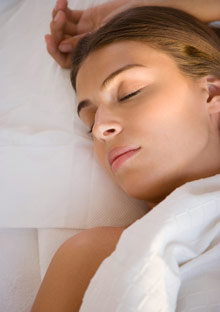The Dangers of Snoring

Photo: © 2009 Jupiterimages Corporation
The window-rattling snores typical of obstructive sleep apnea are no laughing matter. They're the sound of someone struggling to breathe as muscles at the back of the throat relax, blocking the airway. Some people actually stop breathing for up to a minute without ever fully waking up—which not only disrupts deep sleep but can also keep blood pressure elevated throughout the night. Experts estimate up to 18 million Americans have obstructive sleep apnea, yet the majority remain undiagnosed. The health toll from the disorder includes weight gain, stroke, and heart attacks, not to mention debilitating chronic drowsiness that puts you at risk of an accident during daytime driving.
Until recently there was no easy way to diagnose the problem. But last year, Medicare and other insurers began paying for tests that can be taken in the comfort of your own home.
Prescribed by a doctor, some of the tests involve attaching small sensors to your fingers, chest, or forehead to measure the amount of oxygen in your blood (low oxygen levels throughout the night is a sign a sleeper is struggling to breathe) and how much you toss and turn; others include a tube that rests below your nose and captures the volume of your snores along with your airflow. Research suggests that most of the tests are reliable in detecting obstructive sleep apnea; a recent study by Jordan Stern, MD, a surgeon at the New York Eye and Ear Infirmary in Manhattan, and colleagues, found that one—a BlackBerry-sized device that takes readings from sensors on your chest and finger—is 97 percent accurate.
Prices for the tests typically start at about $200—five to 10 times cheaper than spending the night in a sleep lab. If you have a mild case, sleeping with a mouth guard to jut the jaw forward (and keep the airway open) could be enough to solve your problem. For moderate to severe sleep apnea, you might need a machine that sits next to your bed and blows air through your nose.
Experts believe the take-home devices will enable millions of drowsy Americans to get help. "Home testing is going to bring to light that this is a much more common disease than we think," says Stern.
Until recently there was no easy way to diagnose the problem. But last year, Medicare and other insurers began paying for tests that can be taken in the comfort of your own home.
Prescribed by a doctor, some of the tests involve attaching small sensors to your fingers, chest, or forehead to measure the amount of oxygen in your blood (low oxygen levels throughout the night is a sign a sleeper is struggling to breathe) and how much you toss and turn; others include a tube that rests below your nose and captures the volume of your snores along with your airflow. Research suggests that most of the tests are reliable in detecting obstructive sleep apnea; a recent study by Jordan Stern, MD, a surgeon at the New York Eye and Ear Infirmary in Manhattan, and colleagues, found that one—a BlackBerry-sized device that takes readings from sensors on your chest and finger—is 97 percent accurate.
Prices for the tests typically start at about $200—five to 10 times cheaper than spending the night in a sleep lab. If you have a mild case, sleeping with a mouth guard to jut the jaw forward (and keep the airway open) could be enough to solve your problem. For moderate to severe sleep apnea, you might need a machine that sits next to your bed and blows air through your nose.
Experts believe the take-home devices will enable millions of drowsy Americans to get help. "Home testing is going to bring to light that this is a much more common disease than we think," says Stern.



